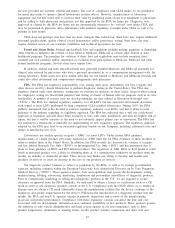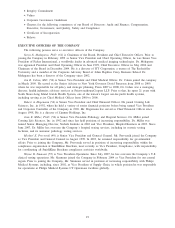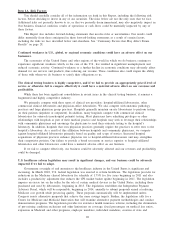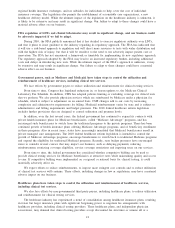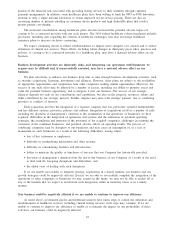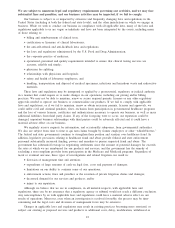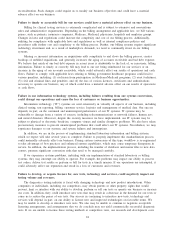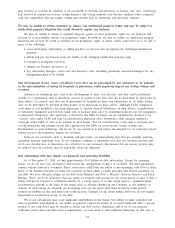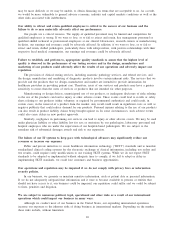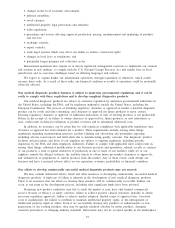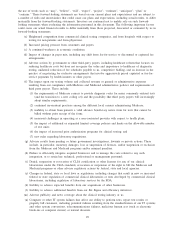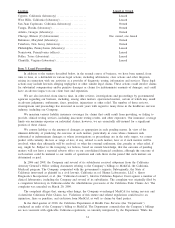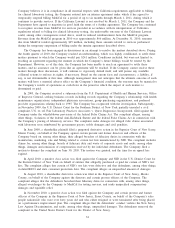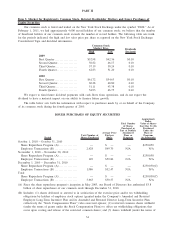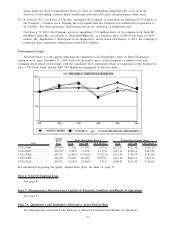Quest Diagnostics 2010 Annual Report Download - page 29
Download and view the complete annual report
Please find page 29 of the 2010 Quest Diagnostics annual report below. You can navigate through the pages in the report by either clicking on the pages listed below, or by using the keyword search tool below to find specific information within the annual report.may be more difficult, or we may be unable, to obtain financing on terms that are acceptable to us. As a result,
we would be more vulnerable to general adverse economic, industry and capital markets conditions as well as the
other risks associated with indebtedness.
Our ability to attract and retain qualified employees is critical to the success of our business and the
failure to do so may materially adversely affect our performance.
Our people are a critical resource. The supply of qualified personnel may be limited and competition for
qualified employees is strong. If we were to lose, or to fail to attract and retain, key management personnel or
qualified skilled technical or professional employees at our clinical laboratories, research centers or manufacturing
facilities, our earnings and revenues could be adversely affected. In addition, if we were to lose, or to fail to
attract and retain, skilled pathologists, particularly those with subspecialties, with positive relationships with their
respective local medical communities, our earnings and revenues could be adversely affected.
Failure to establish, and perform to, appropriate quality standards to assure that the highest level of
quality is observed in the performance of our testing services and in the design, manufacture and
marketing of our products could adversely affect the results of our operations and adversely impact our
reputation.
The provision of clinical testing services, including anatomic pathology services, and related services, and
the design, manufacture and marketing of diagnostic products involve certain inherent risks. The services that we
provide and the products that we design, manufacture and market are intended to provide information for
healthcare providers in providing patient care. Therefore, users of our services and products may have a greater
sensitivity to errors than the users of services or products that are intended for other purposes.
Manufacturing or design defects, unanticipated use of our products, or inadequate disclosure of risks relating
to the use of the products can lead to injury or other adverse events. These events could lead to recalls or safety
alerts relating to our products (either voluntary or required by governmental authorities) and could result, in
certain cases, in the removal of a product from the market. Any recall could result in significant costs as well as
negative publicity that could reduce demand for our products. Personal injuries relating to the use of our products
can also result in product liability claims being brought against us. In some circumstances, such adverse events
could also cause delays in new product approvals.
Similarly, negligence in performing our services can lead to injury or other adverse events. We may be sued
under physician liability or other liability law for acts or omissions by our pathologists, laboratory personnel and
hospital employees who are under the supervision of our hospital-based pathologists. We are subject to the
attendant risk of substantial damages awards and risk to our reputation.
The failure of our IT systems to keep pace with technological advances may significantly reduce our
revenues or increase our expenses.
Public and private initiatives to create healthcare information technology (“HCIT”) standards and to mandate
standardized clinical coding systems for the electronic exchange of clinical information, including test orders and
test results, could require costly modifications to our existing HCIT systems. While we do not expect HCIT
standards to be adopted or implemented without adequate time to comply, if we fail to adopt or delay in
implementing HCIT standards, we could lose customers and business opportunities.
Our operations and reputation may be impaired if we do not comply with privacy laws or information
security policies.
In our business, we generate or maintain sensitive information, such as patient data or personal information.
If we do not adequately safeguard that information and it were to become available to persons or entities that
should not have access to it, our business could be impaired, our reputation could suffer and we could be subject
to fines, penalties and litigation.
We are subject to numerous political, legal, operational and other risks as a result of our international
operations which could impact our business in many ways.
Although we conduct most of our business in the United States, our expanding international operations
increase our exposure to the inherent risks of doing business in international markets. Depending on the market,
these risks include, without limitation:
26


